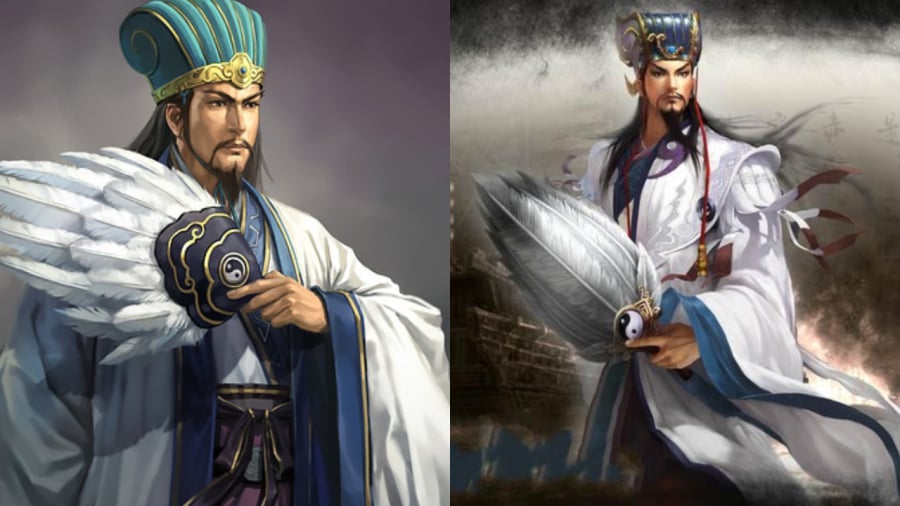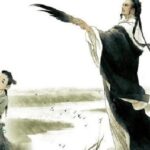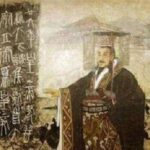Zhuge Liang, or Gia Cát Lượng in Vietnamese, was the renowned chancellor of Shu Han during the Three Kingdoms period. He is often depicted wearing the Bát Quái (a traditional Chinese garment) and sitting casually in a carriage, with a white feather fan in hand.
According to Chinese historian Zhu Yi-Liang, many ancient texts described Zhuge Liang’s fan. One such example is from the Tai Ping Yu Lan (太平御覽), which states: “Liang sat in his carriage, holding a white feather fan, directing his troops with it, advancing and stopping at its movement.” This passage describes Liang’s encampment at Wei Xin.
Additionally, various literary works from the Wei, Jin, Southern and Northern Dynasties also documented Liang’s white feather fan.
For Zhuge Liang, this fan was an indispensable accessory and a significant part of his persona. It accompanied him on numerous battlefields and became a familiar symbol. Moreover, the fan carried multiple layers of meaning and was believed to instill a sense of dread in his enemies.

Essentially, Liang’s fan was initially a personal item. It is speculated to have been made from the feathers of a pheasant or a crane, both known for their pristine white plumage.
Given the scorching weather of the late Han region, having a fan was essential for cooling off and keeping insects at bay.
However, this fan was not merely a utilitarian object; it carried special significance.
Symbol of Zhuge Liang’s Erudite Wisdom and Calm Demeanor
Historical records depict Zhuge Liang appearing with his fan even in tense and perilous situations, exuding an image of confidence and composure. This fan became synonymous with his unflappable nature, contrasting sharply with the chaotic and brutal battlefield.
Liang’s casual fan-waving gesture had a powerful effect, instilling confidence in his troops and causing apprehension in enemies, who feared his profound strategic mind.
The white feather fan represented his erudition and evoked an image of a wise and sharp-minded leader.
A Tool for Command
During intense battles, Liang’s fan served a tactical purpose as well. Some believe that the graceful waving of his fan was a subtle way of signaling and directing his soldiers, though there is no historical evidence to support this claim. Nonetheless, this image of an invisible weapon controlling tens of thousands of soldiers, as depicted in the novel Romance of the Three Kingdoms, is captivating and appealing to readers.
Manifestation of Subtle Power and Authority
Zhuge Liang’s fan also symbolized his authority and subtle power. The consistent presence of the fan in his hand created an unmistakable image of the brilliant strategist believed to possess the ability to control the fate of a nation.
The mere sight of the white feather fan evoked a sense of his profound wisdom and immense influence over the course of wars.
Beyond these interpretations, the image of Zhuge Liang with his fan may also be attributed to literary, cinematic, and television adaptations, where the fan has become an integral part of his iconic persona.
The Tales of Our Ancestors: Lessons That Remain Valuable 5,000 Years Later
China, a country with over 5000 years of history, is renowned for its emphasis on “family values.” The ancient Chinese believed that one must first cultivate oneself and uphold moral virtues to effectively “manage one’s family, govern the country, and bring peace to the world.” This philosophy has left a rich legacy of invaluable wisdom for generations to come.
The Majestic Mausoleum: A 54-Year Odyssey that Surpasses the Greatness of the Qin Emperor’s Eternal Resting Place
The Qin Shi Huang Mausoleum may be an architectural marvel, but prepare to be awe-struck by the Maoling Tomb. With its colossal scale and half-a-century-long construction, Maoling, the resting place of Han Wudi, is undoubtedly one of the most magnificent achievements in China’s rich historical tapestry.



































